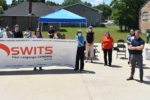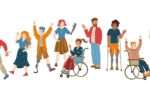Interpreting Requirements
American Sign Language (ASL) is not a signing version of the English language, it is a completely separate language with its own rules, culture, and dialects, used by at least a million Americans as their primary daily communication method. ASL interpreting is in great demand as a result. ASL is one of the most requested types of interpreting in the U.S., in part because providing it is a requirement of the Americans with Disabilities Act (ADA).
How does one become an ASL interpreter? Licensing requirements vary by state. Let’s review the requirements for ASL interpreters in Illinois and Wisconsin.
Illinois Requirements
In Illinois, ASL interpreters are licensed by the Illinois Deaf and Hard of Hearing Commission (IDHHC). The commission is composed of seven members: Four licensed interpreters and three deaf or hard of hearing consumers.
Before being licensed by the IDHHC, interpreters must be certified by the Illinois Board of Examining interpreters (BEI) or the equivalent in another state. The Illinois BEI requires those who test to have a high school diploma or the equivalent, and certifies interpreters at three levels: Basic, Advanced, and Master.
The certification process includes a performance assessment evaluating skill in the English language, ASL, understanding of the cultural norms of the deaf and English-speaking communities, and the ability to operate in a professional and ethical manner according to the standards of the Registry of Interpreters for the Deaf (RID).
Though a Basic certification is sufficient for a license, certain types of interpreting will require additional skills, education, or certifications, just as spoken language interpreting does. For example, being licensed as an educational interpreter in K-12 setting requires that the interpreter pass additional tests (such as the ParaPro test or the RID written test), have an associate’s degree, or 60 accredited college semester hours. It’s also expected that those working in a school setting will have achieved Level 3.5 or above on the Educational Interpreter Performance Assessment (EIPA), though this is not a requirement for the license.
All licensees must pay a licensing fee, and complete annual continuing education.
Wisconsin Requirements
Wisconsin’s Office for the Deaf and Hard of Hearing (ODHH) divides its Sign Language Interpreter licenses by whether the interpreter is hearing or deaf and by level of skill, resulting in four licenses: Intermediate Deaf, Intermediate Hearing, Advanced Deaf, and Advanced Hearing.
Wisconsin also has a BEI with Basic, Advanced, and Master certifications (with requirements similar to Illinois), but the ODHH “will be focusing their efforts on implementing the BEI Basic performance assessment process first.” However, Wisconsin accepts BEI certifications from other states, and other certifications recognized by the RID.
Other requirements for the licenses include:
Intermediate Deaf—
One of the following:
- Forty hours of deaf interpreter training curriculum
- Sixteen hours of Sign Language Interpretation services-related training approved by the RID, the BEI, or substantially equivalent training
- Completion of American Sign Language Linguistics I and II or substantially equivalent coursework
- Two Letters of Recommendation from individuals who hold a Sign Language Interpreter-Advanced Deaf license, a Certified Deaf Interpreter Certification issued by the RID, or equivalent Certification. Letters must show successful completion of at least 25 hours of observing sign language interpreting for clients.
Intermediate Hearing—
Must:
- Earn an Associate’s degree in Sign Language Interpretation or equivalent
- Complete an Interpreter Training Program
- Possess a BEI Basic Certification or an equivalent examination/certification
Advanced Deaf—
- Earn an Associate’s degree or satisfy an alternative pathway for education as determined by the Department.
- Hold a Certified Deaf Interpreter Certification from the RID, or an equivalent certification.
Advanced Hearing—
- Earn an Associate’s degree in Sign Language Interpretation or equivalent.
- Complete an Interpreter Training Program.
- Hold the Advanced or Master Performance certification by the BEI or hold the National Interpreter Certification from the RID, or pass an equivalent examination as determined by the Department.
OR:
Certification of any of the following:
- National Interpreter Certification (NIC), Advanced or Master Level National Interpreter Certification (NIC-Advanced or NIC-Master), Certificate of Interpretation (CI), Certificate of Transliteration (CT), Comprehensive Skills Certificate (CSC), Master Comprehensive Skills Certificate (MCSC), Interpretation Certificate (IC), or Transliteration Certificate (TC), issued by RID.
- The National Association of the Deaf III, IV, or V Certification.
- The Advanced or Master Certification from the BEI.
As in Illinois, Wisconsin ASL interpreters need additional training and certification to serve in medical, mental health, court, and educational settings. They must also pay a licensing fee, and complete annual continuing education requirements.





